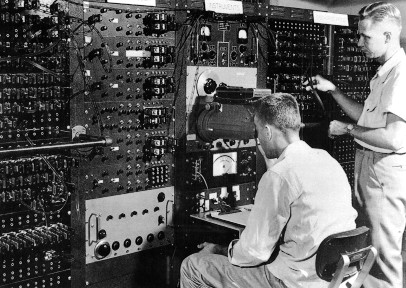Old Analog Computer
Today, an ancient beast outlives its species. The University of Houston's College of Engineering presents this series about the machines that make our civilization run, and the people whose ingenuity created them.
Analog computers were the great promise of the early '50s. We found a small army of natural processes that were analogs of each other. The flow of electricity in a man-made circuit models the flow of heat. Waves in shallow water model shock waves in air. Soap bubbles model electric fields.
The digital computer blew all that away like summer smoke. By the 1960s digital machines let us solve equations in place of making physical analogs. A whole generation of high-tech analog modeling vanished in a few years.
In 1955 the gas industry went looking for a better way to design systems for moving natural gas. 1955 was the heyday of the analog. So they went to an electric analog for gas flow. They went to the Southwest Research Institute, SwRI, in San Antonio. SwRI put in a huge wall of capacitors, coils and resistors.
We look at the system. It stretches from room to room. A task that would fit on a minicomputer today takes up almost 2000 square feet. It's a dinosaur. But there's a catch. This dinosaur is going to enter the 21st century. This dinosaur can look back and smile at the mammoth and the saber-toothed tiger. She's outlived the whole history of the digital computer.
This dinosaur was the best of a breed. It's been used on 6000 industrial compressor systems. On fifty billion dollars' worth of equipment! Over the years, its vacuum tubes gave way to transistors. But the old coils and capacitors are still there. This machine walks around mathematics. It simply dodges the equations that are still so hard to write.
For a generation this grand old machine has interacted with experts. It has become a mirror of engineering experience. It's so like the systems it describes that it speaks to engineers' hearts as well as their heads. Of course we're now writing codes to do the analog's work on digital machines. But as we do, the analog takes on a new role. Now it's an elder statesman. We still use it to design systems, but it also helps test the new digital codes.
High quality gives indefinite life to some of the things we make. The wooden pencil survives hundreds of fancier writing systems. You can still fly on a DC-3. A really good technology has features that make it too good to forget. So it is with the violin, silverware, and the bicycle. And so it is too with this fine old remnant from the computer stone age.
I'm John Lienhard, at the University of Houston, where we're interested in the way inventive minds work.
(Theme music)
For more information on the Southern Gas Association Analog Design Facility for Pipeline Compressor Stations, we refer the listener to
Mr. John Dube
Center for Applied Machinery and Piping Technology
Southwest Research Institute
P.O. 28510
San Antonio, TX 78228-0510
The construction of the Analog Facility was commissioned and funded by the Southern Gas Association and the Pipeline and Compressor Research Council.

Photo courtesy of ASME
Southern Gas Association Analog Design Facility for Pipeline Compressor Stations